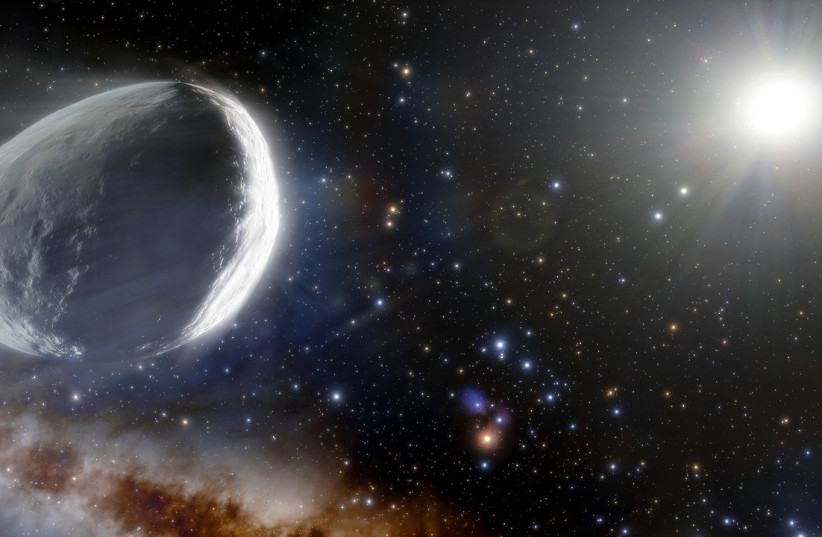A massive comet over twice the size of Mount Everest is barreling inward in the solar system heading past Earth and will be visible in the sky.
Dubbed C/2017 K2 (PanSTARRS), this collossal comet will make its closest approach to Earth on July 14 and will be close to the Sun on December 19.
It won't hit us, but if you have a telescope, you could be treated to an absolute treat in the sky over the summer.
What is this comet?
The comet, C/2017 K2, is a large Oort Cloud comet first discovered in 2017 using the Pan-STARRS surveying tool.
Comets, like asteroids, are one of the most iconic objects found floating around space.
Unlike asteroids, however, which are large rocks, comets are mostly composed of ice and dust, along with some rocky particles. This, in turn, gives them an atmosphere of sorts around the nucleus, though extinct comets lack this and look like small asteroids.
An Oort Cloud comet is a comet that comes from the Oort Cloud, a theorized area at the outer edge of the solar system that is essentially a spherical shell made up of icy pieces of debris. It is these pieces of debris that, when they fall out of the cloud, head towards the Sun and become comets.
This cloud is very mysterious, however. Its exact size and mass is a mystery, and even its entire existence is merely theorized since its many comets are too far for observation, meaning this astronomically large structure is essentially invisible.
When a comet flies close to the Sun, the heat causes it to warm and release gases. This subsequently forms a large bright trail known as coma and sometimes even a tail. These can help make the comets much brighter – which, in turn, makes them much easier to spot, even with the naked eye.
Is C/2017 K2 the biggest comet we've ever seen?
No, it is not.
True, it is absolutely massive. According to initial data gained from observations via the Canada-France-Hawaii Telescope, the nucleus of the comet was thought to be anywhere between 30 kilometers to 160 kilometers wide.
But later observations made using NASA's Hubble Space Telescope paint a smaller picture, giving it a diameter of around 18 kilometers.
Make no mistake, this is still very large. For context, Mount Everest, the largest mountain on Earth, peaks at around 8,000 meters, or eight kilometers in height. That would make this over twice as big.
This is supported by C/2017 K2's coma, whcih is thought to have a diameter of 130,000 kilometers, which is almost the size of Jupiter, and a tail that could be 800,000 kilometers long.
This size is, no pun intended, absolutely astronomical. But while it may top the peak of Everest, it is hardly the peak of comets.
Back in April, a study published in the peer-reviewed academic periodical The Astrophysical Journal indicated that another Oort Cloud comet, C/2014 UN271, also known as Comet Bernardinelli-Bernstein, absolutely dwarfed C/2017 K2 by boasting a nucleus with a diameter of over 128.7 kilometers. For comparison, that would make it wider than the entire US state of Connecticut.
This study was backed up by data from Hubble, as well.
So what makes C/2017 K2 so interesting?
Several things make it interesting, but the biggest feature was the fact that it was "active."
An "active" comet is, simply put, when a comet is bright enough due to its tail and comet being visible, which would make it detectable from Earth.
As evidenced by C/2017 K2's massive coma and tail, this comet is very much active.
However, this is a bit of an issue.
In order for a comet to be active and therefore so visible, it would need to be close to the Sun, since it is the Sun that tends to cause this reaction.
But C/2017 K2 is still far from the Sun. So what's going on here?
That isn't clear. It is possible that the activity is being driven by something else. For instance, ice mixing with other substances. But we don't know for sure.
What is true is that, at the time of its discovery in 2017, C/2017 K2 was thought to be the farthest-known active comet.
Now, this isn't true anymore. In fact, C/2014 UN271 is now the proud bearer of this distinction.
However, it is still a standout example of a strange comet that highlights some of the many mysteries surrounding the mysterious phenomena of our enigmatic universe.
So be on the lookout for C/2017 K2, if you have a telescope on hand, because you just might get treated to a special treat.
If you're more interested C/2014 UN271, though, then you're in for a longer wait, as that comet isn't set to pass by Earth until 2031 – and don't worry, it also won't hit us.


